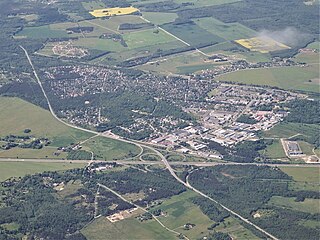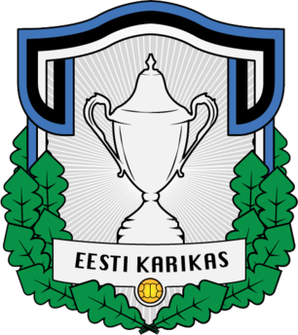| |||||
| Decades: | |||||
|---|---|---|---|---|---|
| See also: | |||||
This article lists events that occurred during 1936 in Estonia .
| |||||
| Decades: | |||||
|---|---|---|---|---|---|
| See also: | |||||
This article lists events that occurred during 1936 in Estonia .
| | This section is empty. You can help by adding to it. (December 2020) |
| | This section is empty. You can help by adding to it. (December 2020) |

Tallinn is the capital and most populous city of Estonia. Situated on a bay in north Estonia, on the shore of the Gulf of Finland of the Baltic Sea, Tallinn has a population of about 454,000 and administratively lies in the Harju maakond (county). Tallinn is the main governmental, financial, industrial, and cultural centre of Estonia. It is located 187 km (116 mi) northwest of the country's second largest city, Tartu, however only 80 km (50 mi) south of Helsinki, Finland, also 320 km (200 mi) west of Saint Petersburg, Russia, 300 km (190 mi) north of Riga, Latvia, and 380 km (240 mi) east of Stockholm, Sweden. From the 13th century until the first half of the 20th century, Tallinn was known in most of the world by variants of its other historical name Reval.

Tallinn Airport or Lennart Meri Tallinn Airport is the largest airport in Estonia, which serves as the secondary hub for AirBaltic, cargo airline Airest and LOT Polish Airlines. It was also the home base of the now defunct national airline Estonian Air. Tallinn Airport is open to both domestic and international flights. It is located 2.7 nautical miles southeast of the centre of Tallinn on the eastern shore of Lake Ülemiste. It was formerly known as Ülemiste Airport.

Saue is a town in north-western Estonia. It's the administrative centre of Saue Parish in Harju County.

Aegna is an Estonian island in the Bay of Tallinn in the Baltic Sea. Administratively it is part of the city of Tallinn, the capital of Estonia and is a sub district of the Kesklinn district.

Harju County, is one of the fifteen counties of Estonia. It is situated in Northern Estonia, on the southern coast of the Gulf of Finland, and borders Lääne-Viru County to the east, Järva County to the southeast, Rapla County to the south, and Lääne County to the southwest. The capital and largest city of Estonia, Tallinn, is situated in Harju County. Harju County is the largest county in Estonia in terms of population, as almost half (45%) of the Estonia's population lives in Harju County.

Established in 1918, Tallinn University of Technology is the only technical university in Estonia. TalTech, in the capital city of Tallinn, is a university for engineering, business, public administration and maritime affairs. TalTech has colleges in Tartu and Kohtla-Järve. Despite the similar names, Tallinn University and Tallinn University of Technology are separate institutions.

Football Club Infonet Levadia Tallinn, commonly known as FCI Levadia, or simply as Levadia, is an Estonian professional football club based in Tallinn that competes in the Meistriliiga, the top flight of Estonian football. The club's home ground is Lilleküla Stadium.

Meistriliiga is the highest division of the Estonian Football Association annual football championship. The league was founded in 1992, and was initially semi-professional with amateur clubs allowed to compete. With the help of solidarity mechanisms, the league is fully professional since the 2020 season.

The Estonian Cup is the national knockout competition in Estonian football. In 2012, the competition was unofficially rebranded as Evald Tipner's Cup. The winner will compete in UEFA Europa Conference League first qualifying round.

Põltsamaa is a town in Põltsamaa Parish, Jõgeva County, Estonia. The town is situated on the Põltsamaa River, and features a 13th-century castle.

The history of Jews in Estonia starts with reports of the presence of individual Jews in what is now Estonia from as early as the 14th century.

Norma Tallinn was an Estonian football club. Norma Tallinn became the first Estonian champions after the Soviet Union collapse, they went on to defend their title next year, in 1993. Norma also won the Estonian Cup in 1994. The club was relegated to the second division in 1995 and to the third the following year. Norma Tallinn were dissolved after the 1996/1997 season.

The Bronze Soldier is the informal name of a controversial Soviet World War II war memorial in Tallinn, Estonia, built at the site of several war graves, which were relocated to the nearby Tallinn Military Cemetery in 2007. It was originally named "Monument to the Liberators of Tallinn", was later titled to its current official name "Monument to the Fallen in the Second World War", and is sometimes called Alyosha, or Tõnismäe monument after its old location. The memorial was unveiled on 22 September 1947, three years after the Red Army reached Tallinn on 22 September 1944 during World War II.

During World War II, the Estonian capital Tallinn suffered from many instances of aerial bombing by the Soviet air force and the German Luftwaffe. The first bombings by Luftwaffe occurred during the Summer War of 1941 as part of Operation Barbarossa. A number of Soviet bombing missions to then German-occupied Tallinn followed in 1942–1944.

FCI Levadia U21 Tallinn, commonly known as FCI Levadia U21, is an Estonian football club based in Tallinn.
The Tallinn offensive was a strategic offensive by the Red Army's 2nd Shock and 8th armies and the Baltic Fleet against the German Army Detachment Narwa and Estonian units in mainland Estonia on the Eastern Front of World War II on 17–26 September 1944. Its German counterpart was the abandonment of the Estonian territory in a retreat codenamed Operation Aster.

Baltic Station is the main railway station in Tallinn, Estonia, and the largest railway station in Estonia. All local commuter, long-distance and international trains depart from the station.

Port of Tallinn is the biggest port authority in Estonia. Taking into account both cargo and passenger traffic, it is one of the largest port enterprises of the Baltic Sea.
The ISU Junior Grand Prix in Estonia is an international figure skating competition. Sanctioned by the International Skating Union, it is periodically held in the autumn as part of the Junior Grand Prix (JGP) series. Medals may be awarded in men's singles, women's singles, pair skating, and ice dance.